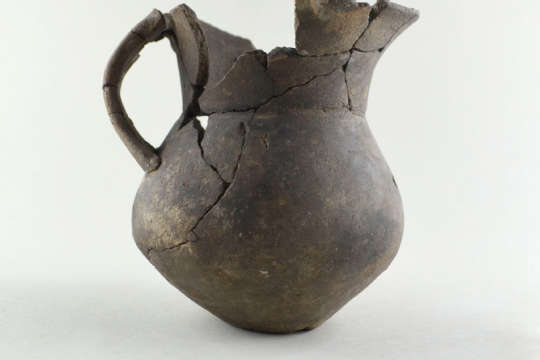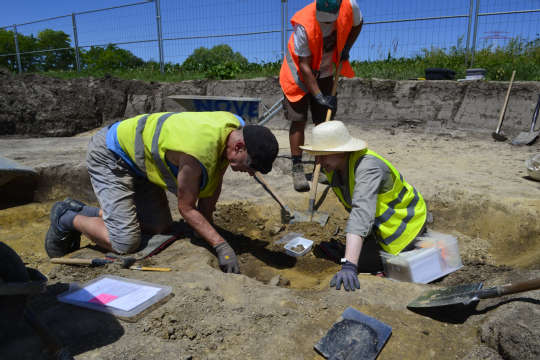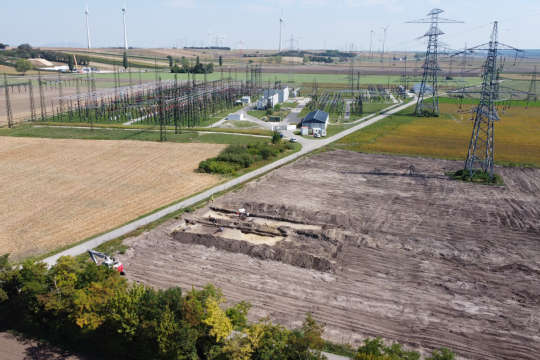Construction site as excavation site: archeological artefacts found at APG substation Sarasdorf
The Austrian transmission system operator Austrian Power Grid (APG) is investing 130 million euros in the expansion and modernization of the substation Sarasdorf over the next few years. In the run-up to the construction work archeologists examined the whole area for traces of the past. To good effect: numerous artefacts of the period between the Bronze Age and Roman times are proof of permanent settlement in the area for more than 4,000 years. The visual highlight is a jug with a handle which is about 3,500 to 4000 years old.
130 million for the integration of wind power and security of supply
The installation of 11 additional 380 kV switchgears as well as two 380/110 kV large power transformers will strengthen the APG site at Sarasdorf in the vicinity of Bruck an der Leitha for the energy transition in Austria. APG spokesperson Christoph Schuh explains: “The substation Sarasdorf is located in the middle of one of the most wind-prone regions in Austria and it is directly connected to the distribution grid of Netz Niederösterreich via a 110 kV switchgear. In the future, it will thus play a key role for feeding in and distributing locally generated surplus wind power via the Austria-wide APG grid. This means that it will be possible to store the locally produced wind power in the pumped storage plants in the west of the country and to make it available all over Austria. In addition, this multi-million investment scheme will facilitate the energy transition of the whole Eastern region and Austria as a whole without jeopardizing the security of electricity supply.”
14 banana boxes and a jug
Since 2006 already – even before the groundbreaking for the then new substation Sarasdorf – the Federal office for the protection of monuments (Bundesdenkmalamt, BDA) as well as archeological service providers have been involved in the project and have been continuously carrying out archeological activities on site. “During the most recent excavation campaign which started in September 2021, we discovered a number of archeological relics – overall they fill 14 banana boxes,” reports Maximilian Bergner of Novetus, who is supervising the excavations on behalf of APG. Banana boxes are the “unit of measure” of archeologists. Bergner elaborates: “The most noteworthy finds include the remains of settlements of the Bronze and Iron Ages, as well as a vast system of trenches from Roman times, which surrounds a Roman farmstead that was already discovered in 2014. A receptacle dating back 3,500 to 4,000 years which has been preserved almost undamaged, is particularly appealing: a jug from the Wieselburg culture, which we excavated and restored last year.”
Substation area as ideal excavation site
According to Bergner the archeological site around the substation Sarasdorf and the relevant research results correlate well with the overall picture of the region. He emphasizes: “The construction site of APG is one of the few sites in Austria where such a vast area, that is over 30,000 m², can be investigated. This gives us a good overview of the various eras in a period of over 4,000 years. In addition, it provides an insight in the life and goings-on in an agricultural settlement in the fertile plain of the basin around Bruck an der Leitha.” According to the archeologist, kilns and several clay pits suggest that the historic settlers produced pottery for their own usage – like the above mentioned jug.
For the time being the artefacts remain with Novetus GmbH, where they are cleaned, preserved and analyzed. Afterwards they will be handed over to APG. Christoph Schuh: “It is impressive how many artefacts from such a long period in history have been excavated at the site of our substation. The combination of significant investments in the infrastructure and the appreciation of the cultural heritage of the location emphasizes our commitment to supporting sustainable development and preserving history.”
Sustainability as part of APG’s DNA
For more than 25 years APG, who is responsible for ensuring the security of power supply in Austria and is playing a crucial role in transforming the energy system without jeopardizing this security of supply, has been committed to protecting biodiversity in terms of environmental protection, species diversity and wildlife conservation by means of systematic habitat management in the vicinity and along its infrastructure.
Areas along the APG grid infrastructure provide habitats for endangered animal species and support the biodiversity of plants. Central aspects in this context are:
- Shaping an environmental-friendly energy transition
- Compensatory measures especially regarding endangered animal and plant species
- Ecological route management in the context of regular operation and with regard to specific land use conditions (e.g. floodplain landscapes, nature reserves)
- Promotion of near-natural nesting aids (e.g. approx. 130 nesting boxes for the saker falcon on APG’s pylons)
- Education projects focusing on topics like sustainability and ecology (e.g. themed hiking trail “Natural Treasures in the Western Weinviertel Region”)
In addition, the a conscious approach to natural resources and history plays an important role in every single one of APG’s infrastructure projects, therefore the cooperation with the BDA and archeology experts is part of our standardized project procedure.
APG‘s infrastructure securely supplies generations of people in Austria with electricity. We take on this responsibility towards present and future generations also when it comes to sustainability in all areas.
Factbox eras:
- Early Bronze Age (2,000 – 1,600 B.C.E.)
- Late Iron Age (or "Celtic times", 450 – 15 B.C.E.)
- Roman times (15 B.C.E. – 6th century)tion
Press contact
Stefan Walehrach



